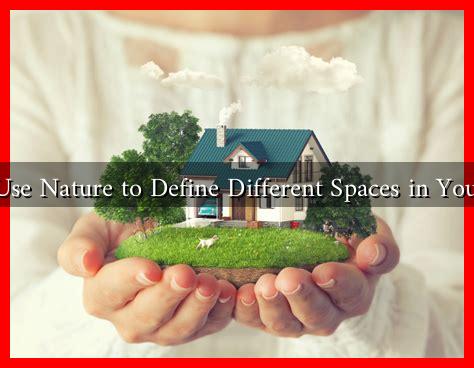-
Table of Contents
- How to Use Nature to Define Different Spaces in Your Home
- Understanding the Concept of Biophilic Design
- Defining Spaces with Natural Materials
- Utilizing Plants to Create Zones
- Maximizing Natural Light and Views
- Creating Outdoor Living Spaces
- Case Studies: Successful Integration of Nature in Home Design
- Conclusion
How to Use Nature to Define Different Spaces in Your Home
Incorporating elements of nature into your home design can create a harmonious and inviting atmosphere. By using natural materials, plants, and outdoor views, you can define different spaces in your home, enhancing both functionality and aesthetics. This article explores various ways to utilize nature to create distinct areas within your living environment.
Understanding the Concept of Biophilic Design
Biophilic design is an approach that seeks to connect people with nature through the built environment. This concept is based on the idea that humans have an innate desire to connect with nature, which can lead to improved well-being and productivity. According to a study published in the journal *Environmental Science & Technology*, exposure to natural elements can reduce stress and enhance mood.
Defining Spaces with Natural Materials
Using natural materials is one of the most effective ways to define different spaces in your home. Here are some materials to consider:
- Wood: Incorporate wooden beams, flooring, or furniture to create warmth and a sense of grounding. For example, a reclaimed wood dining table can serve as a focal point in your dining area.
- Stone: Use stone for accent walls or countertops to add texture and a natural feel. A stone fireplace can define a cozy living space.
- Textiles: Natural fabrics like cotton, linen, and wool can be used in cushions, curtains, and rugs to soften spaces and add comfort.
Utilizing Plants to Create Zones
Plants are a powerful tool for defining spaces within your home. They not only purify the air but also add color and life to your environment. Here are some ideas for using plants effectively:
- Indoor Gardens: Create a small indoor garden in a corner of your living room or kitchen. Use a variety of plants to add visual interest and define the area.
- Vertical Gardens: Install a vertical garden on a wall to create a stunning focal point that separates spaces without the need for physical barriers.
- Planters as Dividers: Use large planters filled with tall plants to act as natural dividers between spaces, such as separating a living area from a dining area.
Maximizing Natural Light and Views
Natural light can significantly influence the perception of space. Here are some strategies to maximize light and views:
- Large Windows: Install large windows or sliding glass doors to bring in natural light and connect indoor spaces with the outdoors.
- Skylights: Consider adding skylights to dark areas of your home to enhance brightness and create a sense of openness.
- Window Treatments: Use sheer curtains or blinds that can be easily opened to allow for maximum light during the day.
Creating Outdoor Living Spaces
Outdoor spaces can serve as extensions of your indoor living areas. Here are some ideas for creating functional outdoor spaces:
- Patios and Decks: Design a patio or deck with comfortable seating and natural elements like wood or stone to create an inviting outdoor area.
- Gardens: Incorporate flower beds, vegetable gardens, or herb gardens to enhance the beauty and utility of your outdoor space.
- Water Features: Adding a small pond or fountain can create a tranquil atmosphere, making your outdoor space more appealing.
Case Studies: Successful Integration of Nature in Home Design
Several architects and designers have successfully integrated nature into home design. For instance, the *Green House* in New Zealand features extensive use of glass and natural materials, allowing for seamless transitions between indoor and outdoor spaces. Similarly, the *Tree House* in Costa Rica utilizes local wood and incorporates large windows to maximize views of the surrounding rainforest.
Conclusion
Incorporating nature into your home design is not just about aesthetics; it’s about creating spaces that promote well-being and functionality. By using natural materials, plants, and maximizing light and views, you can define different areas in your home that are both beautiful and practical. Whether you’re looking to create a cozy reading nook or an inviting outdoor space, the principles of biophilic design can guide you in making your home a sanctuary that reflects the beauty of the natural world.
For more inspiration on biophilic design, visit Biophilic Design.

